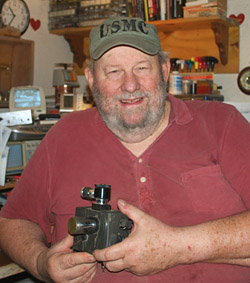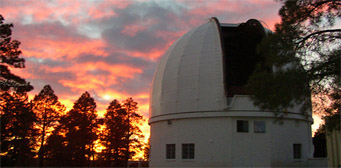The Lowell Amateur Research Initiative (LARI) seeks to pair professional astronomers with technically sophisticated amateur astronomers to conduct exciting research projects.
In no other science is the work of amateur devotees more highly valued (and even sought after) by professionals than it is in astronomy. Oh, sure, a few archaeologists will enlist volunteers to handle their dirty work literally down in the trenches. But the love-fest among professional and amateur astronomers has been going strong for decades and has soared recently as high-end instrumentation finds its way into more backyards.

The Astronomical Society of the Pacific has given its 2012 Amateur Achievement Award to Jeffrey Hopkins of Phoenix, Arizona, who has a long record of achievement (and publications) involving precision photoelectric photometry and high-resolution spectroscopy.
Charlie Hopkins
I'm not referring to the many worthwhile astronomical "citizen science" projects that have blossomed in recent years. I mean real observations — astrometry, photometry, spectroscopy, and good ol' picture-taking — that the pros use to further their research.
OK, we don't discover too many comets and asteroids any more, but amateurs continue to discover novas and supernovas that grateful pros can then follow up from their mountaintops or from space. The American Association of Variable-Star Observers (AAVSO) is arguably more relevant now than it's ever been, and whole conferences are now devoted to scientific research by amateur observers. The list of ways that the two communities communicate and collaborate is long.
So it wasn't surprising at all to learn that astronomers at Lowell Observatory are reaching out to enlist technically proficient amateurs in an assortment of collaborations. The Lowell Amateur Research Initiative offers an "opportunity to participate in cutting-edge research and potentially make significant contributions to science."
Does that pique your interest? The projects already under way include taking deep images of dwarf galaxies, generating light curves for slow-rotating asteroids, and monitoring low-mass stars to determine their rotation periods and reveal transiting planets encircling them.

Sunset envelops the dome of Lowell Observatory's 72-inch Perkins Telescope near Flagstaff, Arizona.
Lowell Observatory
"John and Meg Menke, amateur astronomers and active Lowell supporters, approached us with a proposal to encourage pro/am research collaborations," explains Lowell staffer Antoinette Beiser. "John's initial proposal was focused on forging one-on-one working research relationships between amateurs and professionals." He coined the name LARI (pronounced "Larry").
To get involved, first you'll have to register on the LARI website and crate a profile with your interests, equipment, and experience. More than 100 well-qualified observers have already signed up. The program scientist is asteroid specialist Bruce Koehn. "Some professionals want a close research relationship with one or two amateurs and don't need lots of detailed procedures on web pages," Beiser explains. "Others will have many amateurs working on a project. In these cases, web-based procedures will be critical."
And the rewards for participating in LARI, while not monetary, will no doubt be satisfying in other ways. "The tradition in astronomy is that everyone who contributes significantly to a project is a co-author on the paper that presents the results," Beiser notes. "Ideally, we want each amateur to contribute something significant to each project and receive appropriate credit. We will work toward that goal."
 0
0
Comments
You must be logged in to post a comment.